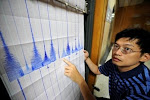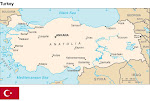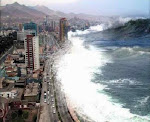 SANTIAGO,Chile-The long-dormant Chaiten volcano blasted ash some 20 miles (30 kilometers) into the Andean sky on Tuesday, forcing the last of thousands to evacuate and fouling a huge stretch of the South American continent.A thick column of ash climbed into the stratosphere and blew eastward for hundreds of miles (kilometers) over Patagonia to the Atlantic Ocean, closing schools and a regional airport.Chilean and Argentine citizens were advised to wear masks to avoid breathing the dangerous fallout.Chilean officials ordered the total evacuation of Chaiten, a small provincial capital in an area of lakes and glacier-carved fjords just six miles (10 kilometers) from the roiling cloud.Interior Minister Edmundo Perez said anyone still in the area should "urgently head to ships in the bay to be evacuated."More than 4,000 people were evacuated over the weekend and 350 more headed out Tuesday.Also emptied was the soot-coated border town of Futaleufu, about 75 miles (120 kilometers) from the volcano.The five-day-old eruption is the first in 9,370 years, said Charles Stern, a volcanologist at the University of Colorado-Boulder who has studied Chaiten.He said the nearby town could end up buried, much like the Roman city of Pompeii following Mount Vesuvius' eruption in 79 A.D. Volcanic material from Chaiten's last eruption measured up to 5 feet in places."What happens after today is anybody's guess," Stern said.The gritty, gray-white blizzard of ash covered houses and roads. Some people chose to remain in Futaleufu, donning masks when they dared to leave their homes.About a 1/2 inch (1 centimeter) of ash coated the Argentine tourist town of Esquel, a Patagonian resort favored by backpackers and skiers at the foot of the Andes, where the airport and schools have been closed since Saturday.The fallout covered a third of Argentina's Minnesota-sized province of Chubut, provincial Gov. Mario Das Neves said.While volcanologists around the world eagerly awaited data on the scope of the eruption, one local expert got an up-close look when he accompanied police and air force teams over the 3,950-foot (1,200 meter) peak.Volcanologist Juan Cayupi told The Associated Press by telephone that Chaiten's two small craters have morphed into a large, single crater.Lava was rising within the crater but has not yet spilled over, said Luis Lara, another volcanologist with the government's Geology and Mining Service.Chilean President Michelle Bachelet, who visited the area Monday, has pledged financial help for people who lose homes or livestock. Farmers left behind about 40,000 head of livestock, and officials expressed fear that many of them could die.
SANTIAGO,Chile-The long-dormant Chaiten volcano blasted ash some 20 miles (30 kilometers) into the Andean sky on Tuesday, forcing the last of thousands to evacuate and fouling a huge stretch of the South American continent.A thick column of ash climbed into the stratosphere and blew eastward for hundreds of miles (kilometers) over Patagonia to the Atlantic Ocean, closing schools and a regional airport.Chilean and Argentine citizens were advised to wear masks to avoid breathing the dangerous fallout.Chilean officials ordered the total evacuation of Chaiten, a small provincial capital in an area of lakes and glacier-carved fjords just six miles (10 kilometers) from the roiling cloud.Interior Minister Edmundo Perez said anyone still in the area should "urgently head to ships in the bay to be evacuated."More than 4,000 people were evacuated over the weekend and 350 more headed out Tuesday.Also emptied was the soot-coated border town of Futaleufu, about 75 miles (120 kilometers) from the volcano.The five-day-old eruption is the first in 9,370 years, said Charles Stern, a volcanologist at the University of Colorado-Boulder who has studied Chaiten.He said the nearby town could end up buried, much like the Roman city of Pompeii following Mount Vesuvius' eruption in 79 A.D. Volcanic material from Chaiten's last eruption measured up to 5 feet in places."What happens after today is anybody's guess," Stern said.The gritty, gray-white blizzard of ash covered houses and roads. Some people chose to remain in Futaleufu, donning masks when they dared to leave their homes.About a 1/2 inch (1 centimeter) of ash coated the Argentine tourist town of Esquel, a Patagonian resort favored by backpackers and skiers at the foot of the Andes, where the airport and schools have been closed since Saturday.The fallout covered a third of Argentina's Minnesota-sized province of Chubut, provincial Gov. Mario Das Neves said.While volcanologists around the world eagerly awaited data on the scope of the eruption, one local expert got an up-close look when he accompanied police and air force teams over the 3,950-foot (1,200 meter) peak.Volcanologist Juan Cayupi told The Associated Press by telephone that Chaiten's two small craters have morphed into a large, single crater.Lava was rising within the crater but has not yet spilled over, said Luis Lara, another volcanologist with the government's Geology and Mining Service.Chilean President Michelle Bachelet, who visited the area Monday, has pledged financial help for people who lose homes or livestock. Farmers left behind about 40,000 head of livestock, and officials expressed fear that many of them could die.But the possibility of the Chaiten volcano affecting Earth's climate is probably fairly low, experts said.So far, Chaiten has emitted only a few thousand tons of sulfur dioxide, "which is very small," said Simon Carn, a University of Maryland-Baltimore volcanologist who uses satellites to measure volcanic gases.In general, a volcano must spew at least 1 million tons of sulfur dioxide into the stratosphere to have a global effect on climate, said Alan Robock, a Rutgers University professor who co-authored a book on the subject.After eruptions of unusual size, sulfur dioxide, converted into sulfuric acid, can form a thin white cloud in the atmosphere that reflects sunlight away from Earth.The Philippines' Mount Pinatubo produced a brief cooling of the climate after spewing 20 million tons of sulfur dioxide in 1991.But Robock said this volcano is so close to the South Pole that any cooling would likely be limited to the Southern Hemisphere.
As in the days of Noah...



















.jpg)


.bmp)
No comments:
Post a Comment